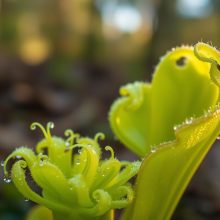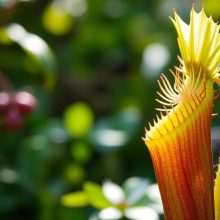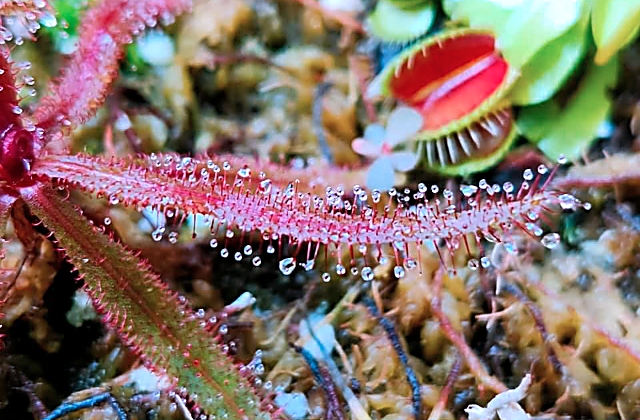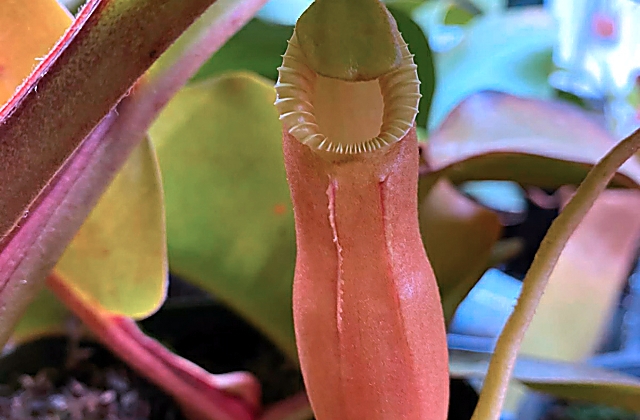Explore the Captivating World of Sarracenia Carnivorous Plants
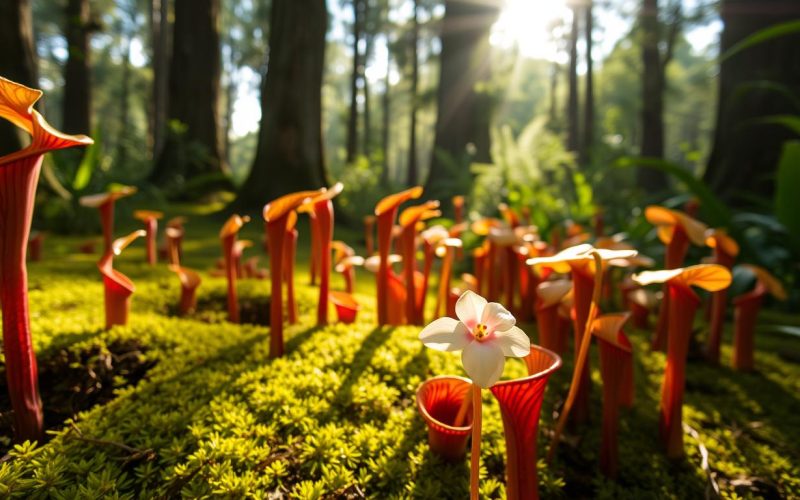
Carnivorous plants have long fascinated scientists and garden lovers. Among these, Sarracenia pitcher plants are truly unique. They are found in North America and have a special way of surviving.
These plants live in wetlands where most plants can’t grow. Their leaves are shaped like pitchers, trapping insects. This lets them get nutrients that other plants can’t.
Sarracenia plants can be found in the sun-drenched bogs of the southeastern United States and Canada’s marshes. They are a marvel of nature. Gardeners and plant lovers find them beautiful and fascinating.
Key Takeaways
- Sarracenia are native carnivorous plants found across North America
- Pitcher plants trap insects using specialized leaf structures
- These plants thrive in nutrient-poor wetland environments
- Sarracenia represent a fascinating example of plant adaptation
- Botanical enthusiasts are increasingly interested in these unique plants
Introduction to Sarracenia
Sarracenia plants are a fascinating group of carnivorous plants from North America. They have a unique survival strategy that makes them stand out. Their ability to capture and digest insects is truly intriguing.
What Are Sarracenia Plants?
Sarracenia plants are known for their pitcher-shaped leaves. They thrive in poor soil by capturing insects. This clever method helps them get the nutrients they need.
- Native to North American wetlands and bog environments
- Belong to the Sarraceniaceae plant family
- Consist of approximately 11 recognized species
The Fascination of Carnivory
The carnivorous nature of Sarracenia plants is a remarkable adaptation. Their pitcher-like leaves are designed to trap insects. The plants then digest the insects to get nutrients.
- Attract insects through colorful, nectar-producing rims
- Use slippery surfaces to prevent insect escape
- Produce powerful digestive enzymes for nutrient extraction
These plants show nature’s incredible ability to adapt and survive. They turn challenges into unique advantages.
Natural Habitat of Sarracenia
Sarracenia plants are fascinating carnivorous bog plants found across North America. They have adapted to survive in tough conditions. This makes their natural habitats truly remarkable.
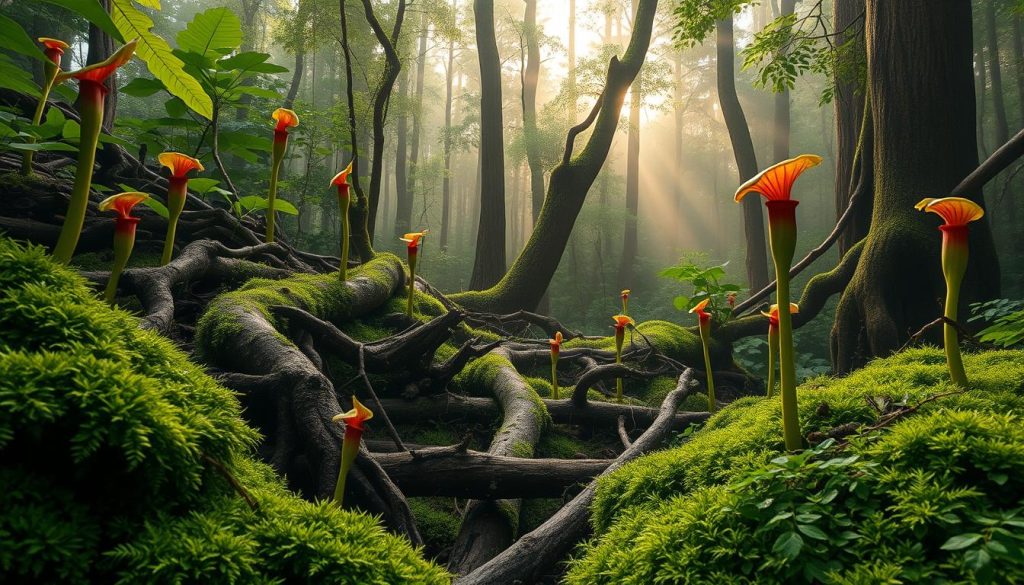
The native range of sarracenia spans several southeastern United States regions, mainly in wetland ecosystems. These plants thrive in places most others can’t survive.
Geographic Distribution of Sarracenia
Sarracenia species are found in specific areas:
- Southeastern coastal plains
- Georgia’s wetland regions
- Florida’s extensive swamplands
- North Carolina’s pocosins
- Parts of Louisiana and Texas
Soil and Climate Requirements
Plant care for sarracenia requires understanding their specific needs. These carnivorous plants need:
- Acidic soil with pH between 3.5 and 5.0
- High moisture content
- Low-nutrient substrate
- Full sun exposure
- High humidity levels
The ecosystem of bog plants like sarracenia is delicate. Their survival depends on nutrient-poor, waterlogged soils. Most plants can’t tolerate these conditions.
Unique Features of Sarracenia
Sarracenia pitcher plants are among the most interesting carnivorous plants. They have amazing adaptations that make them wonders of nature. Their unique structures and survival strategies fascinate botanists and garden lovers.
The Ingenious Pitcher Mechanism
Pitcher plants in the Sarracenia genus have a special trapping system. Their leaves, called pitchers, are like hunting tools. They capture and digest insects.
The pitchers have several important parts:
- Slippery walls that keep insects trapped
- Downward-pointing hairs that guide prey to the bottom
- Digestive enzymes that break down insects
Spectacular Colors and Patterns
Sarracenia varieties have stunning colors and patterns. They range from deep crimson to bright green. Each species has its own unique colors, making them beautiful additions to collections.
The colors and patterns do more than look good. They attract insects, helping the plants survive in poor soil. This clever trick lets them get nutrients they need.
Types of Sarracenia Species
The world of pitcher plants is full of fascinating sarracenia varieties. These plants amaze both plant lovers and scientists. They come in many forms, colors, and ways to survive.
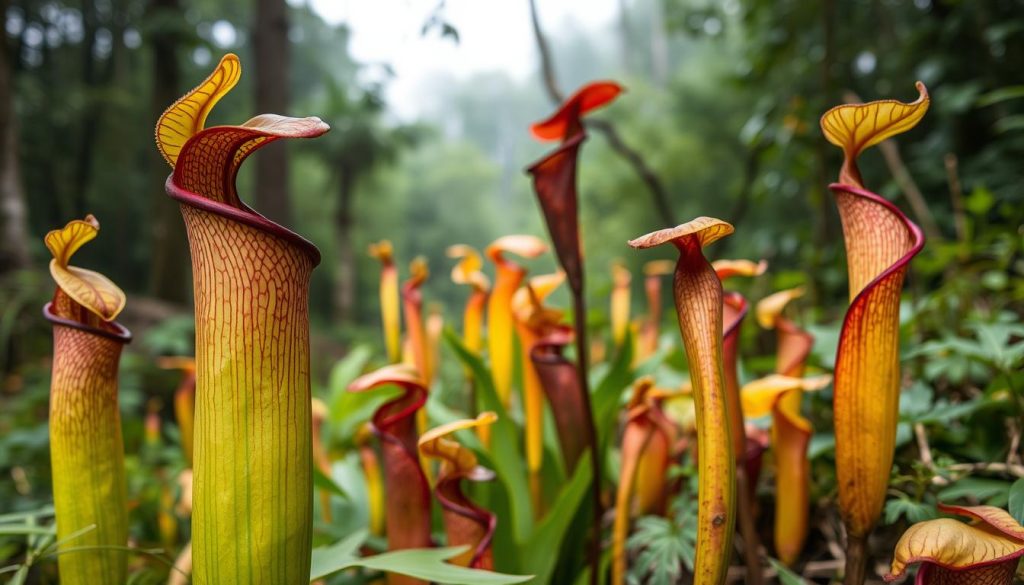
Sarracenia plants are a special group of carnivorous plants from North America. Their leaves look like pitchers and catch and eat insects. This makes them amazing examples of how plants adapt.
Common Sarracenia Varieties
Some sarracenia varieties are known for their unique traits:
- Sarracenia purpurea: Known for its robust purple-tinged pitchers
- Sarracenia leucophylla: Features striking white and green veined pitchers
- Sarracenia flava: Produces tall, bright yellow trumpet-shaped traps
Rare and Unusual Species
Some sarracenia varieties are truly rare and special. Collectors love to find rare ones like the Sarracenia oreophila. It’s found in a few places and has unique colors.
- Sarracenia minor: Grows in specific wetland habitats
- Sarracenia psittacina: Features unusual horizontal pitchers
- Sarracenia oreophila: Critically rare and vibrant green species
Every sarracenia variety shows how creative nature can be. They prove how well carnivorous plants can adapt to tough places.
Growing Sarracenia at Home
Cultivating pitcher plants is a thrilling adventure for plant lovers. Sarracenia, with their unique carnivorous nature, need special care. They are different from regular houseplants. To grow them well, you must understand their specific needs and provide the right conditions.
Essential Care Tips for Pitcher Plants
Pitcher plant care is about creating a habitat like their natural one. These amazing carnivorous plants need certain conditions to thrive. Gardeners must carefully replicate these conditions.
- Maintain high humidity levels around the plant
- Protect from direct wind and extreme temperature changes
- Avoid using tap water with mineral content
- Monitor plant health regularly
Optimal Potting and Soil Selection
Choosing the right soil is key for growing sarracenia. Standard potting soil can harm these plants. So, a specialized mix is vital.
- Use a blend of sphagnum moss, perlite, and sand
- Select containers with excellent drainage
- Avoid nutrient-rich commercial potting soils
- Ensure pot depth allows root development
Light and Watering Requirements
Light and water management are crucial for pitcher plant care. Sarracenia need specific conditions to stay healthy and function as carnivores.
- Provide full sun exposure for 6-8 hours daily
- Use only distilled or rainwater
- Keep soil consistently moist but not waterlogged
- Reduce watering during winter dormancy period
By following these tips, plant lovers can successfully grow these unique carnivorous plants at home.
Propagation Techniques for Sarracenia
Growing sarracenia needs you to know how to multiply them. There are two main ways: seed propagation and plant division. These methods help plant lovers grow their collections.
There are many ways to grow more sarracenia plants. Each method needs special skills and careful steps.
Seed Propagation Method
Seed propagation is a fun way to grow sarracenia. Here’s what you need to do:
- Collect fresh seeds from mature sarracenia plants
- Use specialized carnivorous plant sphagnum moss
- Maintain consistent moisture and temperature
- Provide indirect light during germination
Plant Division Technique
Dividing mature sarracenia plants is another good way to grow them. It’s best done in early spring.
- Select healthy, established sarracenia plants
- Carefully remove the entire plant from its container
- Gently separate root clusters using clean, sharp tools
- Replant divisions in appropriate carnivorous plant substrate
To grow sarracenia well, you need patience and the right environment. You also need to know what each plant needs to grow.
Sarracenia in Ecosystems
Sarracenia plants are amazing bog plants that keep ecosystems in balance. They are more than just interesting plants. They are key to wetland health in North America.
Sarracenia’s role goes beyond their unique way of eating. They create homes for many animals and help the environment.
Biodiversity and Habitat Creation
Sarracenia plants make complex homes in bogs. They offer shelter and food for many creatures:
- Insects hide in the plants’ traps
- Microorganisms live in the plant’s liquid
- Small amphibians use them for safety
Interactions with Other Species
The connection between Sarracenia and other species is interesting. They catch insects for food but also help the ecosystem:
- They give nectar to pollinators
- They create homes for other organisms
- They add to the food web in bogs
Learning about Sarracenia shows how important they are. They help keep nature’s balance and need our protection.
Common Challenges in Cultivating Sarracenia
Cultivating Sarracenia requires careful attention. Successful pitcher plant care means knowing and solving problems that affect plant health. Plant lovers must be ready to face various issues during their journey with carnivorous plants.
Pest Management in Pitcher Plants
- Aphids can quickly infest Sarracenia leaves and traps
- Spider mites pose a significant threat to plant health
- Fungus gnats may damage root systems
Effective care for these plants means fighting pests early. Organic methods like neem oil or insecticidal soap can control pests without harming the plant’s ecosystem.
Disease Prevention Strategies
Fungal infections are a big risk in growing Sarracenia. To prevent them, keep air moving and avoid too much moisture. Watching your plants closely can greatly lower disease risks.
- Keep plants in well-ventilated areas
- Use sterile potting media
- Avoid overwatering
- Remove dead or decaying plant material promptly
Environmental Considerations
Sarracenia plants are very sensitive to their environment. To grow them well, you need to pay attention to light, water, and nutrients. Creating a habitat that matches their natural one is key for their health and growth.
Knowing these challenges helps plant lovers find ways to keep their Sarracenia plants strong and healthy.
Conclusion: The Allure of Sarracenia
Sarracenia plants are a true marvel of nature. They fascinate everyone from plant lovers to scientists. Their ability to catch and eat insects is truly unique.
Growing sarracenia is more than just a hobby. It’s a chance to learn about how plants adapt and survive. People from all walks of life are captivated by these plants’ clever traps.
To grow sarracenia, you need to be careful and know what you’re doing. It’s important to get them from trusted sources and keep their environment right. This way, you can enjoy their beauty and help protect these special plants.
The world of sarracenia is full of wonder and discovery. Whether you’re new to plants or have been growing them for years, these plants offer a fascinating journey. They help us connect with the amazing world of nature.
